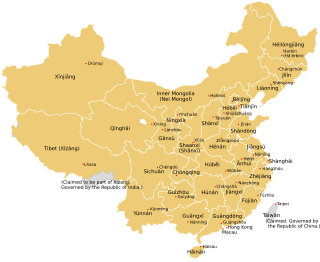
Provincial-level administrative divisions or first-level administrative divisions, are the highest-level Chinese administrative divisions. There are 34 such divisions claimed by the People's Republic of China, classified as 23 provinces, four municipalities, five autonomous regions, and two Special Administrative Regions. The political status of Taiwan Province along with a small fraction of Fujian Province remain in dispute, those are under separate rule by the Republic of China.

Sheng Shicai was a Chinese warlord who ruled Xinjiang from 1933 to 1944. Sheng's rise to power started with a coup d'état in 1933 when he was appointed the duban or Military Governor of Xinjiang. His rule over Xinjiang is marked by close cooperation with the Soviet Union, allowing the Soviets trade monopoly and exploitation of resources, which effectively made a small part of Xinjiang a Soviet puppet state. The Soviet era ended in 1942, when Sheng approached the Nationalist Chinese government, but still retained much power over the province. He was dismissed from post in 1944 and named Minister of Agriculture and Forestry. Growing animosity against him led the government to dismiss him again and appoint to a military post. At the end of the Chinese Civil War, Sheng fled mainland China to Taiwan with the rest of Kuomintang.

Islamic Republic of East Turkestan, was a short-lived breakaway Islamic republic founded on 12 November 1933; it was the first state to style itself an "Islamic republic." It was centred on the city of Kashgar in what is today China-administered Xinjiang Uyghur Autonomous Region. The ETR was primarily the product of an independence movement of the Uyghur population living there and more broadly of Turkic-ethnicity in character, including Kyrgyz and other Turkic peoples in its government and its population.

East Turkestan Republic (ETR) was a short-lived Soviet-backed Turkic Republic. The ETR existed in the mid-1940s in northwest of East Turkistan/Xinjiang. It began as a revolution in three northern districts of Xinjiang Province of the Chinese Republic, resulting in the Ili Rebellion. In 1946 it participated in the Xinjiang Provincial Coalition Government, while maintaining its independence. In August 1947, the officials of the ETR withdrew from the Xinjiang Provincial Coalition Government and re-asserted their independence arguing that all of East Turkistan/Xinjiang should be liberated from Chinese rule. The rest of Xinjiang was under Kuomintang control. This region is now part of the Northern Xinjiang Uyghur Autonomous Region of the People's Republic of China (PRC).
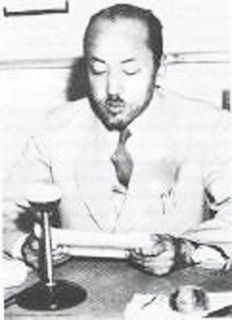
Muhammad Amin Bughra was a Turkic Muslim leader who planned to set up a sovereign state, the First East Turkestan Republic. Muhammad Amin Bughra was a Jadidist.
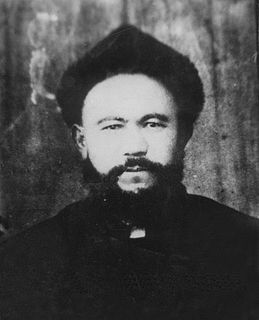
Sabit Damolla was a Uyghur independence movement leader who led the Hotan rebellion against the Xinjiang Province government of Jin Shuren and later the Uyghur leader Khoja Niyaz. He is widely known as the first and only prime minister of the short-lived Islamic Republic of East Turkestan from November 12, 1933 until the republic's defeat in May 1934.
The Xinjiang clique was a military faction that ruled Xinjiang during China's warlord era. Unlike other cliques, its leaders were from outside the province.

Xinjiang is an area located in Central Asia, between 73 ° 5 'to 96 ° 4' east and 35 ° 5 'and 49 ° north, in total 1,660,000 square Km, share border with Mongolia, Russia, Kazakhstan, Kyrgyzstan, Tajikistan, Afghanistan, India, Pakistan and China's Tibet Autonomous Region, Qinghai province and Gansu province. This region had been called Western Regions in China's history and is currently known as the China's Xinjiang Uyghur Autonomous Region in provincial-level.
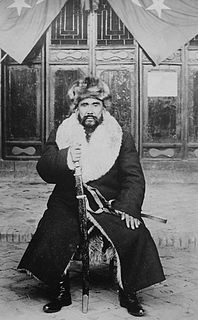
Khoja Niyaz, also Khoja Niyaz Haji, was a Uyghur independence movement leader who led several rebellions in Xinjiang against the Kumul Khanate, the Chinese governor Jin Shuren and later the Hui warlord Ma Chung-ying. He is best remembered as the first and only president of the short-lived Islamic Republic of Eastern Turkestan from November 1933 until the republic's defeat in 1934.
The Ili Rebellion was a Soviet-backed revolt against the Kuomintang government of the Republic of China in 1944. Following the rebellion, the rebels established the Provisional Government of the Second East Turkestan Republic in 1944. The Ili Rebellion was the start of the Three Districts Revolution which lasted from 1944 to 1949.
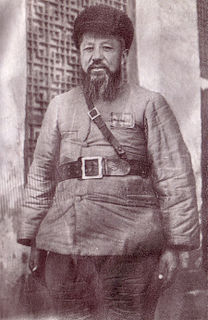
Yulbars Khan, courtesy name Jingfu (景福), was a Uyghur chieftain and Kuomintang general during the Chinese Civil War. He entered the service in the Kumul Khanate of Muhammad Khan of Kumul and later his son Maksud Shah. He served as an advisor at the court, until when Maksud died in March 1930, governor Jin Shuren abolished the khanate. Yulbars then conspired with Khoja Niyaz and Ma Zhongying to overthrow Jin in the Kumul Rebellion. According to some people, Ma restrained Yulbars from traveling to Nanking to ask the Kuomintang for help, Ma earlier had an agreement with the Kuomintang that if he seized Xinjiang, he would be recognized by the Kuomintang as its leader.
The Second Battle of Ürümqi was a conflict in the winter of 1933–1934 at Ürümqi, between the provincial forces of Sheng Shicai and the alliance of the Chinese Muslim Gen. Ma Zhongying and Han Chinese Gen. Zhang Peiyuan. Zhang seized the road between Tacheng and the capital. Sheng Shicai commanded Manchurian troops and a unit of White Russian soldiers, led by Col. Pappengut. The Kuomintang Republic of China government had secretly incited Zhang and Ma to overthrow Sheng—even as they prepared to swear him in as governor of Xinjiang—because of his ties to the Soviet Union. Chinese Nationalist leader Gen. Chiang Kai-shek sent Luo Wen'gan to Xinjiang, where he met with Ma Zhongying and Zhang Peiyuan and urged them to destroy Sheng.

In 1937 an Islamic rebellion broke out in southern Xinjiang. The rebels were 1,500 Turkic (Uighur) Muslims led by Kichik Akhund, tacitly aided by the 36th Division against the pro-Soviet provincial forces of Sheng Shicai.
The Kumul Rebellion was a rebellion of Kumulik Uyghurs from 1931 to 1934 who conspired with Hui Chinese Muslim Gen. Ma Zhongying to overthrow Jin Shuren, governor of Xinjiang. The Kumul Uyghurs were loyalists of the Kumul Khanate and wanted to restore the heir to the Khanate and overthrow Jin. The Kuomintang wanted Jin removed because of his ties to the Soviet Union, so it approved of the operation while pretending to acknowledge Jin as governor. The rebellion then catapulted into large-scale fighting as Khotanlik Uyghur rebels in southern Xinjiang started a separate rebellion for independence in collusion with Kirghiz rebels. Various groups rebelled, and were not united. The main part of the war was waged by Ma Zhongying against the Xinjiang government. He was supported by Chiang Kai-shek, the Premier of China, who secretly agreed to let Ma seize Xinjiang.

Burhan Shahidi was a political leader in Xinjiang, China during the 20th century.

Mahmut Muhiti, nicknamed Shizhang, was an Uyghur warlord from Xinjiang. He was a commander of the insurgents led by Khoja Niyaz during the Kumul Rebellion against the Xinjiang provincial authorities. After Hoya-Niyaz and Sheng Shicai, the newly appointed ruler of Xinjiang, formed peace, Muhiti was briefly appointed by Sheng a Military Commander of the Kashgar region in 1934, but was soon demoted and appointed commander of the 6th Division, composed of Turkic Muslims and named Deputy Military Commander of the Kashgar region. Muhiti opposed Sheng's close ties with the Soviet Union forming opposition to his regime in Kashgar. He organised the Islamic rebellion against Sheng in 1937 and fled to British India. Muhiti was afterwards active in the Japanese-occupied China, fruitlessly cooperating with Japan in order to enhance the cooperation between Japan and Muslims, dying in Beijing.

Dalelkhan Sugirbayev, also Dālil Khan, Delilhan, Delilhan Sugurbayoglu, or Talilhan Sukurbayeff was a Kazakh leader in Xinjiang, China during the first half of the 20th century.

Xinjiang Province or Sinkiang Province refers to a former province of the Republic of China. First set up in 1884 as a province of the Qing dynasty, it was replaced in 1955 by the Xinjiang Uygur Autonomous Region of the People's Republic of China. The original provincial government was relocated to Taipei as the Sinkiang Provincial Government Office (新疆省政府辦事處) until its dissolution in 1992.
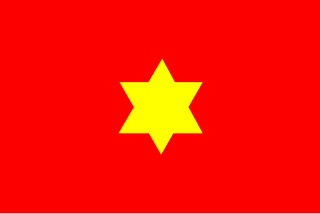
People's Anti-Imperialist Association was a political party in Xinjiang, China during the rule of Sheng Shicai, between 1935 and 1942.
Sheng Shiqi was a Chinese brigade commander in Xinjiang, and the brother of the governor of that province, Sheng Shicai. His murder was a matter of dispute between the Soviet Union and the regional government in Xinjiang, with Sheng Shicai claiming his brother's murder was orchestrated by the Soviets in order to stage a coup, while the Soviets claimed Sheng ordered his brother's murder because of his close ties to Moscow.

















